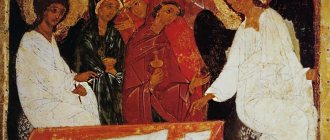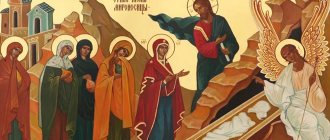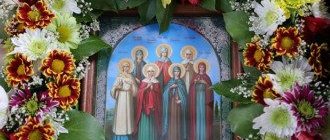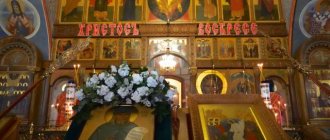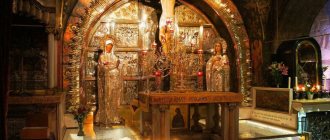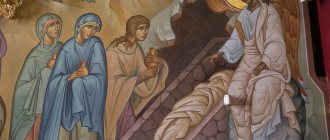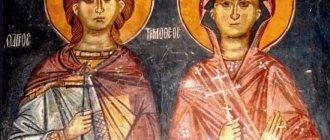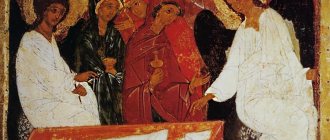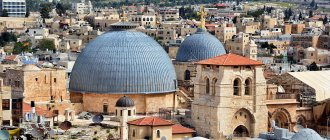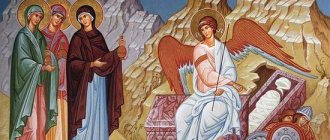Date in 2022: May 16, Sunday.
In Orthodoxy, the Day of the Myrrh-Bearing Women is celebrated two weeks after Easter. In 2022 it will be May 16th. Divine liturgies are held in the church, and according to folk customs, on this day they prepare chicken and egg dishes, congratulate all women, give them gifts, and hold concerts.
| When is it celebrated? | Second Sunday after Easter |
| When was it founded | The history of the holiday begins with the resurrection of Jesus Christ |
| Traditions | Procession of the cross, Divine Liturgy, Celebrations in cathedrals and churches, feasts, cooking eggs and chicken, remembrance of the dead |
In the Orthodox Church, the second Sunday after Easter (according to church canons it is considered the third) is the time of glorifying the feats of holy women: Mary Magdalene, Mary of Cleopas, Salome, Joanna, Martha, Mary, Susanna. The Feast of the Myrrh-Bearing Women will be celebrated on May 16 in 2022. This celebration is dedicated to humble, devoted women. After the crucifixion of Christ, they came to the cave with his body and brought myrrh and aromas.
On the day of the Holy Myrrh-Bearing Women, all women of the world accept congratulations, gifts and attention.
The first witnesses of the resurrection
Photo: Nikola-khamovniki.ru
For their dedication, love and fidelity, the myrrh-bearing women were honored to be the first to see the risen Savior (Matthew 28:9-10). Approaching the Tomb, the wives saw that the stone had been rolled away from the entrance and heard the news from the Angel: “Jesus is Risen!”
“They ran with fear and great joy to tell His disciples that He had risen from the dead” (Matthew 28:7-8).
Subsequently, the myrrh-bearing women, along with the apostles, brought the good news of the Resurrection to the world.
On the week of the Myrrh-Bearing Women. Sermon
Metropolitan Anthony of Sourozh (April 21, 1991)
In the name of the Father and the Son and the Holy Spirit.
We celebrate today the day of the holy myrrh-bearing women, Joseph of Arimathea and Nicodemus. They are barely mentioned in the Gospel until the Passion Days, when Christ was betrayed, taken, abandoned, crucified, killed. But at this time they suddenly appear.
There were no apostles at the cross. Judas hanged himself. And only John stood with the Mother of God, because he was an apostle of love, just as the Mother of God was love incarnate, an expression of all love for God and all Divine love for us, people.
And when the victory of evil over Christ was apparently won, when He was betrayed and crucified, when He died as if irrevocably defeated, then Joseph and Nicodemus appeared, who turned out to be faithful to Him not only in the days of His teaching, but in the days of His defeat. A seeming but obvious defeat, which no one could doubt, and which only love and loyalty to the end could defeat.
And so the question arises before each of us. We know that Christ has won the victory. We cannot become like either the myrrh-bearing women, or Joseph of Arimathea, or Nicodemus in the sense that we cannot return, even with our imagination, to the terrible days of the seeming defeat of the Savior.
He told us: what you did to the smallest, most insignificant person, you did for Me. And we all, without exception, are constantly amazed. We strive for good, and fall away from good; we believe in good and betray good; We strive with all our might to be worthy of the human title, and we fail.
And in these moments, and they happen constantly in our midst, in the midst of all humanity, we must think about the myrrh-bearing women, think about Joseph of Arimathea, about Nicodemus, and stand like a solid rock, supporting each other. “Bear one another’s burdens, and in this way you will fulfill the law of Christ,” says the Apostle Paul.
If we don’t bear each other’s burdens, if we don’t do our best to support each other, if we don’t constantly, thoughtfully, generously treat each other, precisely in moments when it seems to us that our loved one, our friend, is not worthy neither ourselves nor our friendship, we will not fulfill the law of Christ.
Let's think about ourselves and about every person who is around us, about those closest to us and about chance encounters. Let's think about human fragility, how easy it is to slip and fall. And in the moment of defeat we will remain faithful to the end. We will not change with a loving heart and we will not turn away out of fear. And then, indeed, by bearing each other’s burdens, we will fulfill the law of Christ. Then we will enter the host of myrrh-bearing women, unite with Joseph and Nicodemus, and remain with those who throughout the life of mankind were not ashamed of the defeated, did not turn away from the fallen, were God’s love and God’s providence.
Amen.
***
Information about the Holy Myrrh-Bearing Women
Photo: Altai-eparhia.ru
The Holy Tradition of the Church and evangelists have preserved only 7 names of myrrh-bearing women, but it is known that there were more. Among them were: wealthy and noble wives, mothers of families, widows and virgins.
Mary Magdalene
St. Equal to the Apostles Mary was born in Galilee, in Magdala (hence “Magdalene”). It is known from the Gospel that the woman was possessed by “seven demons” (Luke 8:2), which the Savior expelled from her according to her faith. After healing, she constantly followed the Lord (Mark 15:40-41). St. Mary stood at the Cross (Matthew 27:56), comforting the Mother of God and was the first to come to the Teacher’s Tomb. The resurrected Jesus Christ appeared to her, whom she did not recognize, mistaking him for a gardener (John 20: 11-18). St. Mary told the apostles about the Resurrection, and after His Ascension she preached in Rome (Rom. 16:6), where she was not afraid to come to Emperor Tiberius and present him with a gift of an ordinary chicken egg, which, as a sign of the truth of the Resurrection and her words, turned red in her hands. Since then, Christians have been making dyes for Easter. St. died Mary in Ephesus.
Salome
St. Salome was from Galilee. She is the mother of the ap. Jacob and St. John. Her father is Saint Joseph the Betrothed. Together with other wives of St. Salome served the Lord during His preaching in Galilee, stood at the Cross (Matthew 27:55-56), early in the morning went to the Tomb and, having learned about the Resurrection (Mark 16:7), hastened to announce the good news to the apostles.
Maria Kleopova
St. Mary is the daughter of St. Joseph the Betrothed, sister of St. Salome, wife of Cleopas (Luke 24:18), mother of James Alphaeus and Josiah, disciples of the Savior. Like other myrrh-bearers, she served Jesus Christ, stood at the Cross and was honored to see His Resurrection. About the life and death of St. Maria knows nothing.
Joanna
St. John - the wife of Khuza, the courtier of King Herod Antipas, was born into a rich and noble family. When her only son fell ill, the Savior healed him without entering the palace. During the Savior’s preaching, the woman provided Him and the disciples with everything they needed (Luke 8:1-3). Sacred Tradition tells that when St. When John the Baptist's head was cut off, his killers, fearing his resurrection, hid it. St. Joan found the head of St. John the Baptist, secretly took her out of the palace and buried her on the Mount of Olives. Khuza, fearing the wrath of Herod, who soon learned about the action of St. John, divorced his wife. St. Joan followed Jesus Christ and shared the fate of the myrrh-bearing women.
Susanna
Oh St. Susanna only knows that she was a wealthy woman who helped the Savior financially when he preached (Luke 8:3).
Maria Iakovleva
It is not known exactly who this myrrh-bearer was. St. John Chrysostom in his writings identifies her with the Mother of God, and Blessed. Hieronymus of Spiridon - with Maria Kleopova. She is mentioned several times in the Gospel (Mark 15:40; Matt. 27:56; Mark 16:1; Luke 24:10).
Martha and Mary
St. Martha and Mary were born in Bethany. Their brother is St. right Lazarus, whom the Savior resurrected on the 4th day after his death. The sisters are mentioned in the Gospel (Luke 10: 38-42). According to Holy Tradition, after the Ascension of the Lord, Mary and Martha and their brother moved to Cyprus, where righteous Lazarus was a bishop.
When, how and who celebrates this day
Figure 1. St. John the Theologian Monastery, celebration
“Woman's scrambled eggs” or “Kumite Sunday” are other names for the holiday. It is celebrated on the 15th day after Easter (Easter Sunday also counts). This is a genuine international women's day, and not March 8, as is commonly believed in worldly life. This day honors the faithful disciples who followed Jesus to Calvary. All representatives of the fair sex accept congratulations. They are the ones who give life, create the ideals of kindness and all-encompassing love, protect the hearth and harmony in the house, and guide their children and husband in the right direction with their faith in them. The most striking ideal of the feminine principle is, of course, the Mother of God.
Traditions:
- During the holiday week, services are held in honor of deceased saints. Every parish does not forget about the funeral magpie.
- Parents' Saturday represents the remembrance of one's own ancestors. At this time, you should go to the cemetery and take the colored eggs to the grave.
- The celebration is celebrated throughout Russia and abroad. This week all churches, monasteries, cathedrals are full of people, both pilgrims and lay people. The sacred ministers hold conversations, congratulate everyone and wish them joy and goodness.
- The church remembers not only the myrrh-bearers, but also all great women. Particular attention is paid to mothers of many children. The important component of women's participation in the affairs of the church, as a stronghold of chastity and fidelity, is emphasized.
- On Sunday a festive concert is held, often with the participation of children. Many texts from the scriptures are read. The body is anointed.
- In the houses they prepare dishes from eggs and chicken, and organize ceremonial feasts at which grandmothers, wives, sisters and daughters are congratulated.
Previously, under Elizabeth Feodorovna, this date was very revered in the monastery. Where the icon of the Holy Myrrh-Bearing Women was previously located, the relics of the princess are now located.
Procession and celebration of the holiday, 2022
Other ritual options
There was another version of the ritual, in which girls who wanted to kiss each other wove two braids from birch - “skeins”, braiding ribbons in them. At the same time, they asked the cuckoo to save the skein, exchanged cakes and colored eggs with each other. Having made friends, the girls became godfathers, they walked around the village, shared secrets, made good wishes to each other, and gave gifts.
It was believed that after the ritual, the girls entered into a relationship of a spiritual nature, close to that which appears between people who baptize one child in the church. A week later, on the Sunday following Trinity, the girls returned to the place where they committed suicide. Accompanied by songs about repentance, they unraveled wreaths and returned gifts. This meant that their girlhood was coming to an end, they were entering marriageable age and must prepare themselves for family life.
After this, a feast was held in the forest, under the birch trees. His main dishes included boiled and fried eggs, flatbreads, pancakes, and pies. Alcoholic beverages included beer. At the same time, the girls sang songs, danced, and danced in circles.
Actions with birch trees were not always limited to curling and unbraiding braids. In some Russian provinces, a tree was cut down and decorations such as scarves, ribbons, and flowers were hung on it. Then they picked it up and carried it around the village singing. After this, the birch tree was installed in the center of the settlement, and on Trinity Sunday, again accompanied by songs, all decorations were removed from the tree, and it was floated down the river.
On the week of the Myrrh-Bearing Women. Sermon
Archpriest Vasily Ermakov
Christ is Risen! Moved by love for Their Teacher, the myrrh-bearing women were the first to go to the tomb, ahead of the disciples. And what: an empty cave appeared to their women’s eyes, they saw two angels sitting at the tomb, who announced to them about the resurrection of the Lord Savior... For almost 2000 years, this truth of faith has been proclaimed to the human race. And this day... can be called a great day, the day of the myrrh-bearing women. Not on that woman’s humiliated, spit-stained, insulting March 8th Day, on which the crazy world shouts to the humiliated woman: “This is your freedom, this is the goal of your life.” They also shout to us men: “Let them rest and have fun.” What a cynical, humiliating holiday. You, like me, are people of the old generation, and think: “What does this far-fetched holiday give for the purpose of life, and especially for the female soul?” What does it give? That was back then. At work there is widespread drunkenness, some modest gifts and some flattering, sugary slogans and words. And she, a Soviet woman, a poor poor thing, goes to her house, where no one is waiting for her, only children, carrying something in her purse, beaten down by the grief of earthly life.
But our holiday, the holiday of the myrrh-bearing women, it inspires, it supports, it strengthens, it says: “The purpose of a woman’s earthly life is to preach about Christ the Savior” - the Good News. So that she would be completely devoted to God, our long-suffering Russian passion-bearer, daughter of Russia. This is her eternal purpose, this is her holy, God-ordained path of earthly existence, this is why not a single woman in the world has been given that great omnipotent, incomprehensible to the Western world, power of grace. Why do we, deceived, humiliated, insulted by life, so joyfully, patiently, without shouting, like those mad demonstrators, bear the cross for our Fatherland - for our crazy husbands, fathers, grandfathers, those who sought to destroy Orthodoxy, destroy Mother Russia , Holy Rus'...
Everything was aimed precisely at killing in a Russian woman faith, modesty, bashfulness, patience, hope not in human, but in God’s help. Everything was directed and everything was done to seduce with this dirty holiday of the past, so that she would forget the thousand-year history of her not earthly, but Divine purpose - preaching about Christ, the annunciation of eternity, and giving the world new disciples of faith and Orthodoxy.
The Western world did not like this greatest feat and still does not like it. That is why they poured, are pouring on us all the evil spirits of that terrible music, that pornography, that shamelessness in which they themselves were defiled, smeared, toiled in this mud of lies and they bring it to us from the West. We see them: both literature and broadcasts. Especially this dirt will not touch you and me morally, but our children, and our grandchildren, a girl’s pure, fragile soul? She yearns for this dirt and, not obeying the tearful appeal, the cry of mothers and grandmothers: “don’t go, don’t look, don’t leave,” she casually waves at our words with her young gaze running to nowhere, and off she goes...
Before the war, everything was aimed at destroying the Soviet woman, who was still fragile at that time. This is a red scarf, leather jackets, boots, life without a family, and so on. And then the thunder of war forced them to come to their senses, look back, and when they saw, even in our city, how children were dying in their arms, how they died from bombing, from hunger, how refugees into the occupation, into the cold, into hunger were dragged by the hand 2 -3-year-old children... Here is payment, terrible, bloody payment to the Moloch of demonism for the fact that they, perhaps, went to dances in churches at that time. Because that leadership was entirely aimed at ensuring that pre-war youth danced in church buildings and clubs. We know this from experience, and now the reckoning has come.
Also in the post-war period: someone looked around, someone looked back, someone returned, found the way to the temple of God, to Christ. And someone said: “Well, thank God, the war is over, now life will become easier” - but how can it be easier to live without understanding? “Let’s forget God, we won’t go to church. We will earn a pension." I am a living witness to this, I heard this while serving in St. Nicholas Cathedral. And again the payment is the payment from the time of Brezhnev, and even now: a miserable pension and so on, the humiliated, slavish position of grandmothers. What you sow is what you reap.
And the one who followed God then, who, despite all the seductive propaganda, walked to Christ, now lives, rejoices, triumphs, and is already at the age of 80 walking towards the eternal threshold of life. This is life, this is the path of every Christian, and especially a believing woman, a myrrh-bearing woman, a evangelist woman, a crusader woman, a woman who staunchly stands for Russian Orthodoxy, who does not give in, who does not run to spit-stained stadiums, who does not listen to the false preaching of the West, those foreigners who shout at us in an incomprehensible language that we do not know Christ. Don't we know how to pray? That we have forgotten Christ? Why have we not had God in our lives during this 1000-year history? They climb, they sneak, they brazenly break into the house of our Orthodox soul. It is your child’s feat to say: “Don’t listen, don’t walk, don’t meddle, don’t talk. You will live in the conditions in which we lived. Why don’t you want to listen to us: a simple, spiritually literate Russian woman, Orthodox, as I tell you about Christ?” They don’t listen, they shamelessly, silently contemplate. They penetrate into our consciousness, into our Rus', into our situation. And no one will courageously exclaim, scream with the voice of the truth of Orthodoxy. Because you yourself don’t know your native faith. You yourself do not visit the temple of God, you yourself do not fulfill that church prescription of the discipline of fasting and prayer. So, what can a mute say? But only with a nod, agreeing that he is both deaf and dumb, and does not hear, and does not understand.
And so, if every daughter of Orthodoxy, a daughter of Russia, follows Christ, firmly confessing her Orthodoxy, says to her bright ones - and you know how to speak, our Russian women - with a word of truth, all the evil spirits of the West will depart. This bastion of your prayer, your word of God’s truth must come from your lips, from your heart, from your mind - fortunately, today there are all the conditions, there are all the possibilities and the field of activity. It is beyond the threshold of the temple to protect our native Holy Rus' with the word of truth. So that they feel this in the heart of a Russian woman, a Christian woman. We still have time... And this, my dear ones, must be preserved, must be carried, and so that the world of the West with its lies does not approach us, and all lies are broken against the solid armor of Orthodoxy, faith, strength and patience. This is what the holiday is about, what we so joyfully proclaim to the world on the glorious days of Holy Easter, when our lips say: “Christ is risen!” - “Truly Christ is risen”! So let each of our Russian women proclaim the great power of God’s truth.
Amen.
***
Joanna and Maria Kleopova
Somewhat more extensive information is available about John. It is known that she was married to one of King Herod’s close associates and was a very rich woman. It is generally accepted that during Christ’s sermons she took upon herself the bulk of the expenses associated with His life and work. In addition, she has another important merit. It was Joanna who secretly buried the head of John the Baptist on Mount Elion, which Herodias threw into a landfill after desecration.
From the limited information about Mary of Cleopas, another glorious follower of Christ, who was included in the number of the Myrrh-Bearing Women, it is known that she was a relative of Jesus, but the opinions of researchers differ on the degree of relationship. According to one version, she was the wife of Cleopas, the brother of Joseph the Betrothed, and according to another, although less probable, she was the sister of the Blessed Virgin Mary.
Names of the Myrrh-Bearing Women
Who are these women who have forever left their memory in history, and in whose honor the Day of Myrrh-Bearing Women was established? Evangelists call different names, but based on the analysis of the texts they left and taking into account the Holy Tradition, which also tells about this event, it is customary to include the following names among them: Mary Magdalene, Mary of Cleopas, Salome, Joanna, Martha, Mary and Susanna. Let's take a closer look at each of the names. The icon of the “Myrrh-Bearing Woman” presents us only with a plot composition compiled on the basis of a gospel event. For more detailed details, let us turn to the Holy Scriptures and Holy Tradition.
The Mother of God is the first to receive the news of the Resurrection of the Son
And finally, speaking about the Myrrh-Bearing Wives, one cannot fail to mention the mother of Jesus Christ - the Most Holy Virgin Theotokos. Despite the fact that formally She is not one of them, according to many researchers, there is reason to believe that the names Mary of Jacob and the “other Mary” mean the mother of Jesus Christ.
The basis for this may be the fact that after the death of Joseph the Betrothed, Mary took charge of his children from his first marriage, and was quite legitimately considered the mother of his son Jacob. However, even if these assumptions are not true, the Most Holy Theotokos was the first to receive news of the resurrection of Her Son. According to Holy Tradition, she received this good news from the lips of an angel.
Feast of the Myrrh-Bearing Women in iconography
This theme was widely reflected in Byzantine and later in Russian fine art. Almost all of the most famous icon painting schools left works based on this biblical story. However, compositionally many of them differ from each other. So, for example, the icon of the Myrrh-Bearing Woman, a photo of which is presented at the beginning of the article, depicts seven female figures, and the next one after it depicts three. This is explained precisely by the fact that in different texts their number is indicated differently, as noted above.
Iconography
Many different icon paintings have been created depicting the myrrh-bearers. The oldest icon, which is dedicated to holy women, was created more than two thousand years ago. On it you can see girls carrying vessels with oil in one hand and lighted torches in the other. Later, other images began to appear showing angels sitting near the cave with the body of Jesus. The most famous icon is the image called “The Appearance of an Angel.” It is he who can often be found in temples.
Another famous work is the iconostasis of the Trinity Cathedral, which was created in the fifteenth century. Here events taken from the Gospel take place near high mountains. An angel who descended to earth sits on a small stone. His wings are slightly raised up. The myrrh-bearers stand facing the angel, but their gaze is directed inside the cave. This icon depicting a cave is considered the most widespread in Rus' and therefore can be seen both in temples and in homes.
Maria Yakovleva and Susanna
Regarding the woman who is referred to in the Gospel as Mary of Jacob, there is an opinion that she was the youngest daughter of Joseph the Betrothed. It is also known from Sacred Tradition that being on the warmest terms with the Mother of God, she was Her closest friend for many years. It is named Yakovleva in honor of her son, the Apostle James, the closest disciple and associate of Christ.
The least information is available about the Myrrh-Bearing Woman named Susanna. The text of the Gospel says about her only that she served Christ “from her property,” that is, from the material resources she had at her disposal. This makes it possible to conclude that she was a wealthy woman.
By naming these seven names, we act only in accordance with the Orthodox tradition, but not the established canon, since researchers have other points of view that also deserve attention. Often, but not always, the holy Myrrh-Bearing Women are depicted on icons in precisely this composition - seven humble figures.
Names of the day among the Slavs
In East Slavic culture, today's Day of the Myrrh-Bearing Women had its own interpretations and names, for example:
- Indian holiday.
- Women's holiday.
- Babya Bratchina (Shapshikha).
- Kumitnoe (Kumishnoe).
- Margoski (Morgosier, Margoshenier).
- Grandma's scrambled eggs.
- Indian week.
- Curly Sunday.
- Lalynki.
- Babskie saints.
As can be seen from some of the names, the holiday was dedicated to women and was accompanied by various rituals.
One of them was cumulation, in which girls who were approaching marriageable age took part. As a rule, it was carried out on the day when the birch tree was curled. Two girlfriends approached the birch tree, on which a wreath was placed, from both sides, and kissed through it three times. At the same time, they invited each other to kiss each other, never quarrel and become friends forever. After this, crosses and small gifts were exchanged.
Orthodox Women's Day
In memory of these women, the church established a holiday - the Day of the Myrrh-Bearing Women. This is a holiday of all Orthodox women, a kind of analogue of the generally accepted Women's Day - the Eighth of March. The only difference is that Clara Zetkin, in whose memory the official Women’s Day was established, professed the very dubious principles of a revolutionary rebel and a reckless feminist, while those who early in the morning saw the Holy Sepulcher open carried within themselves a living faith and love - the same feelings that only women are capable of. This is where the principle “in weakness lies strength” is clearly demonstrated. The symbol of the holiday is the icon of the Myrrh-Bearing Woman.
